A personal, definitive report of my culinary school experience at George Brown College
Don't wanna be here? Send us removal request.
Text
[I wrote a restaurant review a few weeks ago for an assignment for my Art of Eating and Dining class, taught by Joanne Chimenti. It’s casual, with some personality to it, steering clear of that any pretentious shtick (ahem, Globe and Mail. You’re reviewing restaurants, not the cure for the common cold). Full disclosure, this article is 100% original: should this blog be caught in the web of reverse article searching for plagiarization, I once again reiterate that this article was 100% written by yours truly. All photos were taken by Pengwei “Chris” Feng]
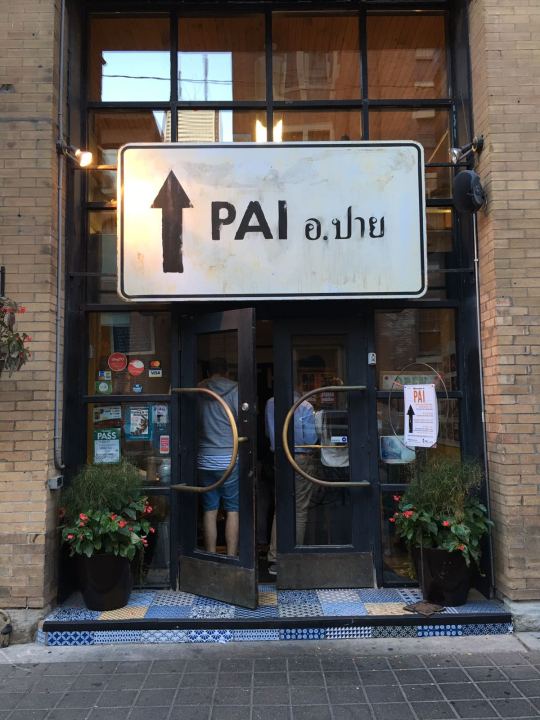
You might miss Pai if you’re not actively looking for it. From the outside, there’s no telling that the rustic, brick-built establishment is a restaurant; only a curious sign hangs above to offer any insight of its identity—and a vague one at that. The patio is a dead give away, sure, but the general feel doesn’t exactly give off that je ne se quois. It’s all curiously minimalist—but alas, you should never judge something by its exterior, no?
Pai—named after a town in Northern Thailand—is the latest venture by backpacking restauranteurs Nuit and Jeff Regular. The duo are no strangers to Toronto’s food and dining scene, having successfully launched Sabai Sabai and Sukhothai—both quaint, modest Thai food spots filtered with a modern edge. With restaurants proliferating in Toronto at a rapid speed, Pai seeks to stand out from the crowd with a mission to blur the line between the classic and the modern. Their ethos is a promise of simple, traditional flavours set against a backdrop of a nostalgic ambiance; authenticity is clearly something they strive for. If Sabai Sabai and Skuhothai felt more catered towards the “foodies” crowd of Instagram, Pai is Toronto’s answer to a Thai food dining experience that rises beyond image. Being cool isn’t Pai’s primary concern. Instead, the restaurant falls back to the basics, prioritizing food and ambiance as the forefront of their selling factor. There are no gimmicks here: it’s all for the love of service and hospitality.

Upon entering, a staircase welcomes patrons to the core of the hustle and bustle of the venue. Immediately to the right, an open kitchen designed in lieu of the wooden houses of Thailand blows enticing scents of spices and herbs into the air. There is incense burning somewhere, engaging your senses with such warmth that the experience makes you feel strangely at home. To the left is a bar called Bebop named after a local music house in Thailand; a takeout station is placed meekly nearby, designed to be reminiscent of a street vendor cart. It’s not hard to understand that Pai’s curated atmosphere is easily a love note to Thailand’s renowned nightlife, where an abundance of street carts and modest, small-scale restaurants are dotted throughout for nightcrawlers and hedonists looking to grab a quick bite. The concept may seem foreign to white-tie lovers, but Pai manages to translate the best of Thailand’s attractions to something intimate and personal.
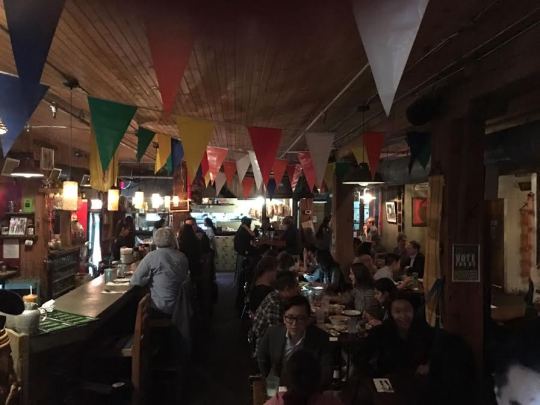
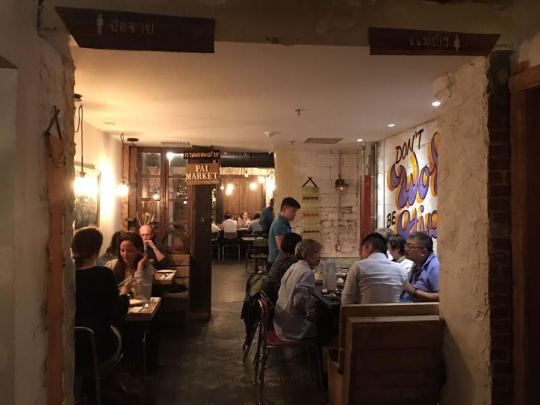
Various pieces from the motherland are scattered in maximalist fashion throughout its brick-walls, a stark contrast compared to the restaurant's simplistic exterior. The low-ceiling concept venue is illuminated by dimly-lit lighting; photos of the Regulars’ homeland can be seen next to tasteful graffiti art pastiched from the streets of Bangkok. There is never a boring moment in Pai; the ambiance is constantly lively, with never a quiet moment to spare. Here is a stern warning, though: those that want a little breathing room for coherent conversations may find it a bit of a challenge at Pai.
The venue’s spacious hall offers eclectic seating options, including an alcove area where diners sit on cushions on the floor. Those looking for a more casual style of dining can choose to sit at the bar: watching mixologists work their way like chemists is an added plus to the entertainment factor of Pai. There is even a private dining area with a communal table. Whatever your choice may be, the lively atmosphere of Pai completes any method of dining.
The slightest smudge in Pai’s meticulously cultivated brand is perhaps their service. The waiting staff were affable; they greeted us amicably and seemed engaged with exchanging basic pleasantries. Yes, the service met all the minimum requirements expected from any restaurant: efficiency, thoroughness, and a sense of decorum. However, our server, in particular, felt as if she was rushing certain aspects: drinks and the like were not explained thoroughly, and questions about certain dishes were corresponded with a vague nondescript. While this wasn’t a huge negative, it may certainly be a red flag for those that are not quite familiar with Thai cuisine and looking to expand their palette. With that said, we decided to ask for a recommendation and was underwhelmed by her pick: the usual spring roll appetizer with pad thai and, yes, a regular fried rice for our entrées. Recommending the safest choice when asked is certainly not an anomaly for a restaurant per se, yet we could not help but feel that a more adventurous recommendation would have been far more memorable. Alas, it’s all personal preference, and we were more than accommodating to order her selections. Oh, and how could I almost forget to mention: almost all the food on the menu can be made vegan. How about that?
As we were staring in awe at the mixologist using an unidentifiable tool that looked something like a centrifuge, we were delighted—albeit suspiciously surprised—that our food was served in less than 20 minutes. We started with our appetizer—the three spring rolls ($8)—filled with sautéed mushrooms, carrots, bean sprouts and glass noodles. The rolls had a delectably crispy texture with a majestic golden colour. However, spring rolls can only taste so good and generally speak for themselves; it would inherently be criminal for them to be anything less than delicious. Yes, they were savoury. Yes, they acted the part as the ideal appetizer. But they were also largely forgettable. Once our plate was finished, our attention was brought back to the mixologist. Pai truly is an entertaining spot, yet we grew despondent that it felt more like a café next to a gift shop at an acclaimed museum, rather than an actual restaurant.
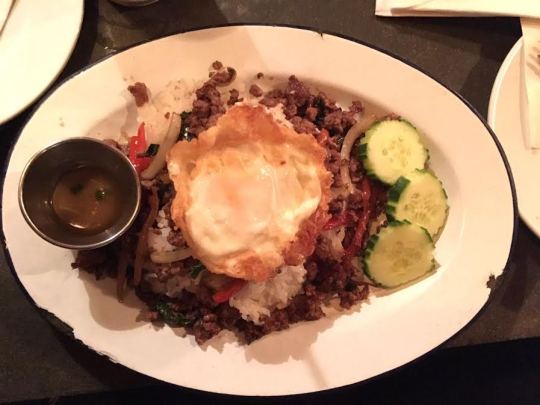
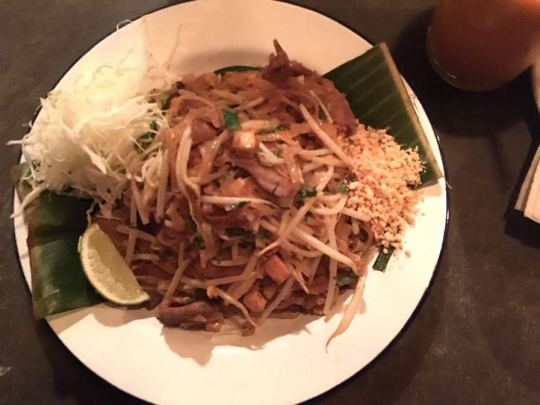
The fried rice ($13) was presented on a basic dish; it wasn’t a spectacle, nor did we expect it to be. I want to preface this next statement with the reassurance that it is not meant to be passive-aggressive, but perhaps a garnish other than three sliced cucumbers placed on the side would have made it far more exceptional?
The actual food itself, however, was cooked and seasoned to near perfection. The combination and ratio of onions, red peppers, and beef paired with nam prik nam pla sauce produced a piquant yet smooth mouthfeel. The dish was topped with a fried egg which helped tie all the different flavours together in a creamy coating. It also tasted exceptionally natural, as expected from the Regulars’ culinary mantra of prioritizing authenticity with no caprice. MSG clearly has no room in this restaurant. The pad thai ($15), however, put both of us at a figurative precipice. The noodles were cooked generally well: soft with a smattering of denseness. However, during our meal, we noticed that some of the noodles would often clump together. I’m not a big meat eater, but apparently the meat in the pad thai was tender, however slightly tough to the bite perhaps due to overcooking; the vegetables proved this by being mushy in texture. Despite some trivialities, the dish was salvaged by Pai’s famed home-made tamarind sauce: a subtly sweet and savoury nectar that was balanced out by toasty and sparkling notes of crushed peanuts and lime, respectively. Despite the sauce being used rather lightly, the flavours almost seemed to build on as we progressed, never revealing its full flavour until the very last bite. The portion was generous but perhaps overly so to the point where one portion could probably satisfy two patrons.
Pai is a restaurant with so many strong ideas, yet the execution often feels tangled. The restaurant’s mission to perfect a truly authentic culinary experience while upkeeping their atmosphere still seems like a lofty goal. The ambiance of Pai replicates the spirit of Thailand’s nightlife, yet the food cannot stand on its own. The flavours peak, but never truly blossom, and the service seems to graze past only the bare minimum. Pai is truly a gorgeous spot, but it is a half-felt experience. It is ideal for a casual dinner with old friends, but as it is now, it still feels like the morning after a spontaneous night out: you come home struggling to remember just what it is you ate, but shrug it off because there’s always going to be a new spot to check out in this city.
NAME Pai Northern Thai Kitchen LOCATION 18 Duncan St, Toronto, ON M5H 3G8 PHONE (416) 901-4724 WEBSITE paitoronto.com PRICE $15 to $20 RATING 2.5/5
[Words by Wooju Lee; photography by Pengwei Feng]
0 notes
Text

I had a dream a couple weeks ago where I was at a butcher shop—and before I continue, I know this is all severely superfluous; being subjected to hearing other peoples’ dreams is the social equivalency of being shown your friends’ baby photos when you never asked. But hear me out... because I really could not think of any other way to start this blog post otherwise. I wouldn’t necessarily call it a fever dream, obviously because I wasn’t sick, but the ambiance of it all: the ominous droplets of water echoing from a leaking facet somewhere, the red-tinged, Lynchian hue of the entire dream, the fact that no one was actually there but me. All of it made it just so unsettling. I didn’t see the butcher or any staff for that matter. But the meats were lined up neatly behind the glass partition and was priced in what seemed to be Egyptian hieroglyphics.
Why do I mention this? Well, I recently made a blog post that went over the matter of me officially starting the process of trying to de-vegetarian (not a word, I know) myself in the past few months. To avoid reiterating myself in full detail, it has been a tad bit of a challenge. But is it really that serious to warrant an entire dream about it? I don’t think so. I didn’t get caught up over decoding just what that dream was supposed to symbolize, I just found it funny that I would be doing something similar for school.
Now, to segue into what I should be talking about: I really don’t know anything about the specifics of meats—be it the cuts or how to handle and cook said parts. I look at one of those diagrams of a pig or cow where all the parts are outlined, and the only thing I can think of is 1. It looks cool, in a morbid way 2. I can’t believe consuming living animals has been reinforced/normalized in our society for so long to the point where we have identified every part and crevice of most if not all animals 3. A friend of mine used to have a poster of a pig diagram on her wall. I don’t know why because she’s studying physics right now. It could be the fact that she was a heavy metal fan. Something about a pig carcass is totally metal, it seems.
Truth be told, I was never fond of beef. Even before going vegetarian, the only instance where I would actually have it is if it was incorporated into a certain dish. With that said, I’m Korean. And yes, we love our pork—especially samgyeopsal (삼겹살). Fun-yet-semi-depressing fact: the whole pork belly and soju combo has more or less become a nightmarish touchstone in the hierarchical system of the South Korean office workplace (or just about any workplace in general). Forget calling it a tradition, it is more or less a mandatory ritual for all employees to go out together nearly bi-monthly: yes, that means the boss is there, as well, and they don’t even pay usually. Rookie employees are often peer-pressured in gulping down soju like water. They are then peer-pressured some more to do ridiculous things to entertain their superiors, like sticking a spoon in an empty bottle of soju and singing a song in front of the whole restaurant. Because refusing to do so means you will be remembered as the disobedient one. The rebel. Abuse of authority happens in just about any environment where there are striking imbalances in power, but it is more extreme over there.
This blog post is getting dark real fast, so let’s get back on track. You may say that I’m already familiar with pork so writing about it seems obsolete, but that’s really not the case. I mean, if I really think about it, the only cut of a pig I’ve tried is the belly. Now, I haven’t had pork in a long while, and I’m still not really sure if I’ll ever wake up one morning and get a craving for it. But I also proclaimed in that aforementioned post that I want to gradually lessen the lifestyle I chose solely for the purpose of going somewhere in this industry. Because whether I like it or not, I’m going to have to cook all sorts of animal flesh. Pardon me if that sounds morbid, but so it goes!
My choice of pig part (there really is no eloquent way in phrasing this) is the shoulder blade, or if you will, the top portion of the front leg of the hog. According to Pork Be Inspired, a website that is apparently dedicated to pork lovers, the terminology for pork shoulder can vary widely depending on the region. The lower ‘arm’ portion of the shoulder is most commonly called the arm pork roast, while the upper part is often called the blade roast, stemming from the area near the loin. The blade is known for its well-marbled cut, making it ideal for pot-roasting it whole, or dicing it up into pieces for stews, or even cooking it over moist smoke to make a classic pulled pork barbecue. Honestly speaking, I don’t know what any of this means. Vegan meats generally just come in chunks, or less commonly, a block (think Spam); the more expensive brands are usually pre-seasoned and don’t really require any other additional cooking other than heating it up.
Some of the most popular methods of cooking this cut are braising, grilling/barbecuing (is that even a word?), roasting, using a slow cooker, or stewing. The shoulder or shoulder blade cuts are also rather inexpensive; it can also be purchased with the bone intact (averaging to about six to nine pounds) or boneless (averaging four to seven pounds). Pork shoulder is also used for making ground pork, which sounds… interesting, to say the least.
My initial plan was to go to the St. Lawrence Market for some exploring, some sight-seeing (because, hell, the last time I was there was on a school trip in high school). Maybe get a smoothie or something. It’s crazy: I always walk by it, and every time I do, I keep telling myself “Hey man, you have the privilege of living in semi-poverty in one of the most diverse cities on earth. Why can’t you get off the bed and explore?”. But alas, I went there after-school this past Monday only for it to be closed. So note to self: do your assignments early next time. Also maybe use Google for the hours of operation. Because Google is free and it’s in the palm of your hands.
So, what to do next? I had to compromise. My option was either the Loblaws near Church-Wellesley (I personally call it the Loblaws Dome, because that’s literally what it is) or the Metro near the Ryerson Rogers Communication Centre. Honestly, that Loblaws makes my anxiety go haywire: it’s too bright (the entire building is one big sensory overload), the lighting makes me look like I spent a month drinking Vodka in a hole, and there’s always too many people there. And thus I ventured over to the Metro instead. I know what you’re thinking: you’re wasting time and energy, Wooju. So what if it’s further? I barely exercise so I could really use this. I need this, man.
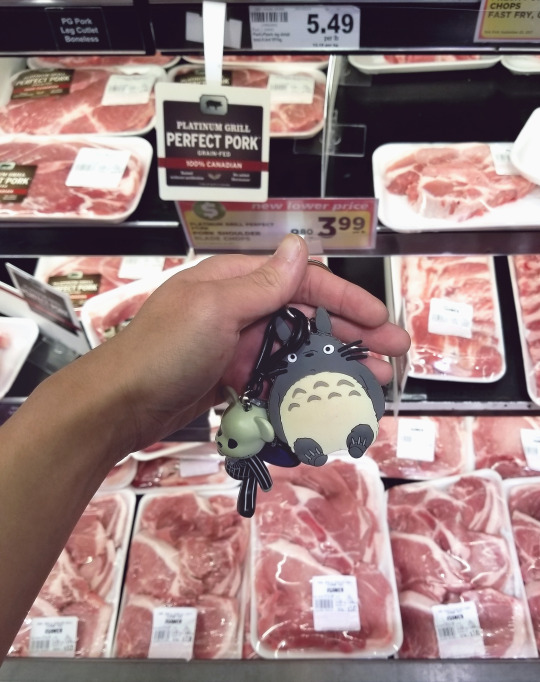
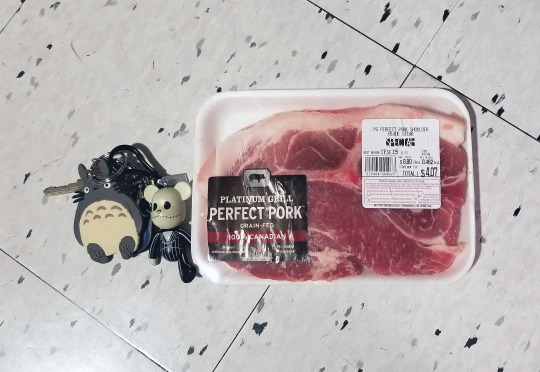
Unrelated-but-sort-of-related-note: The assignment asked us to take photos with a personal belonging for the sake of preventing plagiarism. That’s why my keys make an annoying appearance. You have no idea how much of a challenge it was for me to find the right timing to take a photo of this on the cold, hard floors of Metro.
The recipe I chose is a Korean dish called bossam (보쌈), less commonly just called sooyook (수육), which literally translates to “water-meat” and sounds just as unappetizing in English as it does in Hangul. Bossam is cooked through a wet (moist-heat) cooking method that is essentially just boiling the meat in flavoured brine. Aside from the obvious, this is done to remove excess fat, grease, and blood from the meat, resulting in tender mouthfeel. If I remember correctly, pork sometimes has a very distinctive odour that varies in severity depending on which packet you buy at the groceries; it’s kind of like an innocuous game of Russian roulette. The good news is that this unwanted smell can be removed by boiling the pork with an assortment of things, such as onions, garlic bulbs, bay leaves, and, yes, instant coffee mix. Some higher-end restaurants will bump up the price tag just because they use ginseng or other medicinal herbs, but that can be reserved for yuppies.
So why did I choose bossam? Despite being recognized as one of the more popular comfort foods in Korea, bossam is actually a pretty healthy dish (well, as healthy as pork can get), care of its wet cooking method. There’s no cooking oil or any additional trans-fat involved, making it healthier than, say, bokkeum (pan-fried) or twigim (deep fried) type dishes.
Truth be told, I haven’t actually had bossam since I was about 12 or so, but it is generally served with a side of napa cabbage leaves and perilla leaves. The Korean way to eat any meats, grilled or otherwise, is to wrap it in the aforementioned vegetables with a smattering of ssamjang (쌈장)—a traditional Korean sauce made of gochujang and doenjang. Some prefer to just dip it in saeujeot (새우젓), a fermented food made with small shrimps. It’s all up to personal preference!
This post has been unexpectedly lengthy, so I’ll cap it off with the recipe. I found this rendition through a YouTube cook by the name of Maangchi. She is a Korean-Canadian ahjumma who apparently started her YouTube channel out of sheer boredom. What an icon and a queen! I adore her attitude, and the fact that she single-handedly built a brand for herself is pretty incredible. It goes to show that women should never feel the need to be held back or withhold their passions, just because this patriarchal society reinforced the idea that marriage should be their ultimate end-game. it is not, and it never will be.
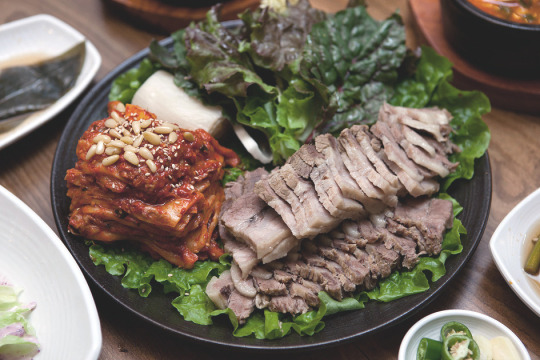
Fun but hedonistic fact: It’s socially acceptable to drink in public in South Korea. It’s like a watered-down version of the infamous North legalizing (and possibly advocating) the use of an assortment of illicit drugs. As for us South, we really love our alcohol. Hell, soju now comes in little juice box containers with the straw and everything.
Ingredients:
3 lb pork shoulder, shoulder blade, or pork belly, rinsed and drained
1 large onion, cut into quarters or sliced
2 tbsp ginger, sliced thinly
12 garlic cloves
2 tbsp Korean fermented soybean paste (doenjang)
1 tbsp brown sugar
1 tbsp instant coffee or any ground coffee
10 cups water
1 lb napa cabbage leaves, washed and drained
¼ cup sugar
¼ cup white vinegar
1 tbsp salt
¾ cup water
Method:
Add the pork, onion, ginger, garlic, soybean paste, brown sugar, coffee mix, and the water to a large pot. Cover and cook for 1 hour over medium-high heat.
When it boils vigorously, turn the pork over with a wooden spoon or tongs.
After 1 hour of boiling, turn down the heat to low and cook for another 15 minutes.
Take out the cooked pork and let it cool down until ready to serve.
Combine sugar, vinegar, salt, and water in a large bowl. Mix well until it turns into a clear pickle brine.
Add the cabbage and mix well by hand.
Let it sit for 15 minutes, then mix well and turn it over so the leaves pickle evenly. Repeat this every 10 to 15 minutes for 1 to 2 hours until the cabbage gets soft and withered.
Squeeze out the excess water and refrigerate until ready to serve.
[Logo design by me; bossam image courtesy of Fooding Me]
0 notes
Photo

On top of working on the first blog post of the semester, I decided to give this blog a little revamping of some sorts.
Aside from that, you could probably tell by the nonchalant nature of my last few posts that I want this blog to be more casual, a little more personal if you will. Maybe have some fun with it? Yikes. It may seem unprofessional, but this is a blog, mind you!
[Design by me; font is Futura, slightly modified by yours truly]
0 notes
Text

Semester 2 of chef school starts today!
Here are some basic updates: I probably should have mentioned this back in that introduction post in May, but I’ve been trying to de-vegetarian myself for the past 4 months (after close to 6 years of abstaining from meat), all to some varying degrees of success. I’ve started using chicken and beef stock, I’ve had veal and lamb for the first time. I even had a goddamn blood sausage over the two-week break: it sucked. I’m still undecided if I’ll actively seek out and eat meat outside of the kitchen, but I realized that if I truly want to take chef school and the career path as a chef seriously, I’m going to have to commit to this change. Because, hypothetically, once I start working, I can’t straight up refuse to cook a recipe that incorporates meat. I can’t just shrug and go “Well, gee, chef so-and-so, I really can’t cook any of this unless I replace it with non-animal products. So I’m gonna go to the back room and watch reruns of Arrested Development on my phone.” No. That’s not how things work. The service industry means having to adhere to what the customers want, even if it means going against my personal beliefs. And besides, I’m in culinary school to learn: I can’t just put in half the effort in cooking a chicken breast or steak because I personally wouldn’t eat it. I have to learn to cook meat. I need to know the taste. I need to know the details, the specifics, the blueprint of how to cook and serve all sorts of meats. Because I’m not cooking for myself, I’m cooking for other people. So all in all, I need to stop being stubborn and be a bit open-minded (and I already am pretty open-minded, so admitting this kind of pisses me off!).
To be completely candid though, dear stranger, the past four months have been rough. People assume that vegetarians or vegans are all deadly against meat and meat eaters. People assume those battling with depression and generalized anxiety are just aloof, uninterested assholes; groundless assumptions become invisible attacks in the form of gestures, of tone and timbre in someone’s voice. It’s not hard to register all of it, especially when you are astute to a fault. Kind of like me.
Getting back on track to the case of circumventing vegetarianism: while there may be some extremists that absolutely have to let other people know of their lifestyle as if it’s some sort of verbal tic, I am not one of them. I think the reason why I struggled as much as I have with getting back to eating meat is that I’ve just been so used to the lifestyle I chose 6 years ago; it’s more or less trying to break a habit... an incredibly innocuous habit that would kind of be detrimental to my culinary career in the long-run. I mean, when I see meat, I don’t grimace. I simply choose not to purchase or consume it, only because I’ve been more or less self-conditioned to be this way.
And besides, I’m not a 17-year-old that draws anarchy symbols at the pen testing station at Staples anymore; the origins of my vegetarian lifestyle is admittedly out of a naïve fascination with Morrissey (Jesus Christ, I was so dumb) and a smattering of wanting to seem cool and edgy. Animal rights is still a cause that I hold dear to me, but there are myriads of ways to advocate those beliefs without necessarily committing to a certain lifestyle.
Second update: I made a second Instagram account (@woojuetc) to showcase my cooking, as well as tidbits of art and photography and what not. I call it a “scrapbook Insta”. That sounds so lame, I just realized, but whatever. It’s fine.
You can probably tell that I’ve been feeling a tad bit down about chef school: there’s dealing with my mental illnesses, the meat-eating thing being another issue (this sounds so gross out of context). But also due to me having the misfortune of dealing with some homophobic people as if I’m in high school all over again. I’ve also realized that I need to...reconsider my stance and attitude with all this. I don’t particularly think I have an attitude problem; anything that says otherwise is me fighting an internal struggle with my anxiety, which has gotten pretty severe to the point where communicating itself is more or less a hassle. It’s just... I have absolutely no poker face or tactic in hiding what I feel. And honestly, this has probably stemmed from 5 years of journalism school, where everyone is pissed off and ready to figuratively rip each others’ work; being in a cut-throat-competitive environment where everyone is in it for themselves have made it a bit of a challenge for me to readjust to a team environment. What I’m trying to say is, if I truly want to do this, which I do, I also need to stop acting out.
I already realize being gay in a mainly heterosexual-dominated industry is going to be hard (seriously, George Brown, you really couldn’t bother to hire one gay chef, at least for the sake of diversity hire?). But where I stand now, where I am at in this industry, I am in no place to be angry at the world. I’m starting out from the bottom and learning everything, and looking pissed off really is not going to help me professionally. And I’m genuinely thankful to a certain chef for teaching me this in the most terrifying way. Besides, if I survived a football-and-hockey oriented Catholic high school in the suburbs of Peterborough, Ontario, where gay-bashing was more or less left as is, I can honestly handle anything. I’ve been living by myself since I was 16; learning to depend on myself, to become completely independent, has become a method of survival. When even your own parents perceive your lifestyle, your true self as something incorrect, something abnormal, there’s nothing you can do but be your own idol. To love yourself on all fronts. And I am so grateful to the people that supported me and continue to support me.
I want to conclude this with a positive-but-still-punk-rock outlook, in memory of my 17-year-old self listening to Fugazi and smoking stolen cigarettes with my friends at the back of PCVS (because SPSS would straight up call the cops on us): OI! BRING IT ON WORLD. WHAT DO YA GOT FOR ME?!
PS. The new LCD Soundsystem record is EVERYTHING important in my life right now. Buy it, stream it, gift it to your cool gay uncle for Christmas.
[Image source: Photograph taken by me, sometime around 2011]
youtube
0 notes
Text
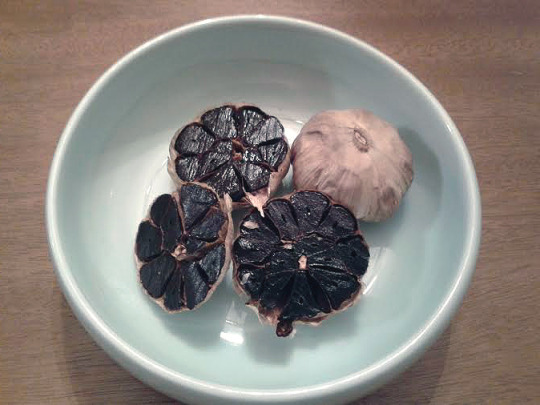
Black garlic (흑마늘; heukmaneul) is a type of treated garlic produced through a fermenting process. When the sugars and amino acids present in the garlic undergo fermentation, these elements produce melanoidin—a dark-coloured substance that is responsible for the aptly titled black garlic. Tracing its origins is quite the challenge; a quick Google search offers nothing but hardly-credible information and a myriad of Internet forum hypothesis. It may or may not be a Korean product, according to Star Chefs; it was supposedly “fermented” in clay pots in the warm summer sun. Other sources claim that it hailed from Japan or even Egypt. Less likely but better documented, Korean inventor Scott Kim claims to have developed black garlic in 2004 as the next big superfood.
Truth be told, I had very little awareness of black garlic’s existence—at least until it was the focal plot point for an episode of the animated sitcom Bob’s Burgers. Little did I know, black garlic has become a staple ingredient in a variety of professional American kitchens since it was manufactured by Kim under Black Garlic Inc. Four years forward, the company began shipping products to stateside chefs. "It's deep. The flavours are so layered, and they linger," says Chef Evan Hanczor of Brooklyn's Parish Hall. "It has notes of dark caramel, chocolate, a little bitterness, a little sweetness, and umami, plus that je ne sais quoi."
Companies that mass-produce and distribute black garlic focus on a long, careful process of keeping garlic heated at a constant temperature of about 60°C (140°F) for a few weeks—to even a month! It’s not particularly hard per se, but it’s no easy task either, and its retail price reflects its tedious process. But because of its widespread popularity in South Korea, many DIY lovers (such as yours truly) have put it on themselves to make it at the comforts of home—using only a rice cooker. Precisely, literally anyone can make it. It only takes a bit of patience. And Febreeze. And a strong will. Also a strong mentality because of the smell...which is so bad, it’s heroic.
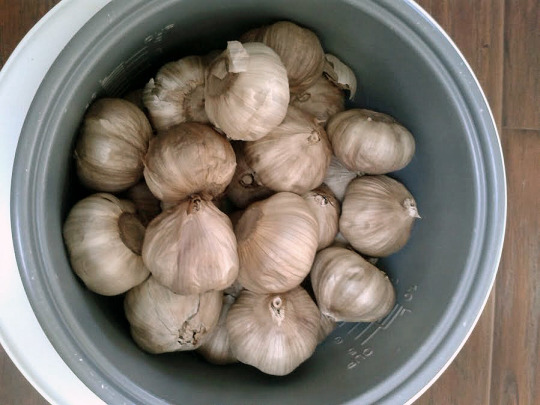
Ingredients
10 whole garlic bulbs
Equipment
Rice cooker with a “Keep Warm” function. If the rice cooker you’re using doesn’t have this, it’s pretty much useless in this case. Keep in mind that the treatment process will leave your rice cooker with a persistent garlic stench, so I suggest buying an older one from Value Village, like I did.
Lots of Febreeze, scented candles, fancy soaps out in the open etc.
Method
Place the rice cooker in an area with good ventilation—preferably somewhere that’s not your kitchen as the smell will permeate any enclosed area. And it’s not even a subtle smell, either. Because I live alone, I had the wonderful privilege of using the garage at my friends’ humble abode at Spadina Road (shout out to Aaron for helping me avoid a potential smelly chaos).
Peel the outer skin of the garlic so that you can see the separation of the garlic cloves. Make sure you do not break the garlic apart!
Place the whole garlic bulbs in one layer in a rice cooker.
Close the lid and press the “Keep Warm” button. Leave it as is for two weeks (approximately 14 days, obviously).
After the allotted time has passed, turn off the rice cooker, take out the garlic bulbs and let them rest until they come to room temperature. Multiple sources claim that it’s best to just leave it as it is for an extra two to three weeks, but because of time constraints, I disregarded that altogether.
After the garlic bulbs have cooled down, start peeling them—this will be easy to do as the cloves are mostly separated from the skin at this point due to the treatment process.
Place the cloves on a parchment-lined baking sheet. Cover with another parchment and air-dry in a cool area for a week. Keep cool.
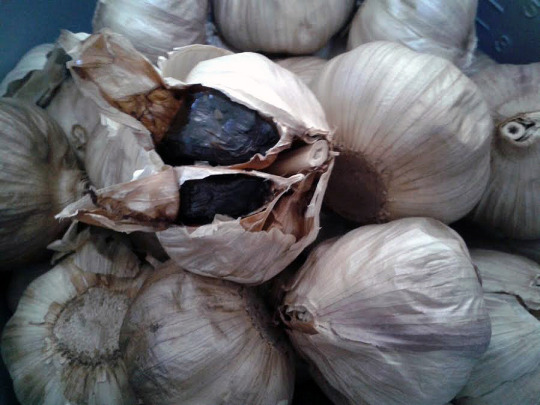
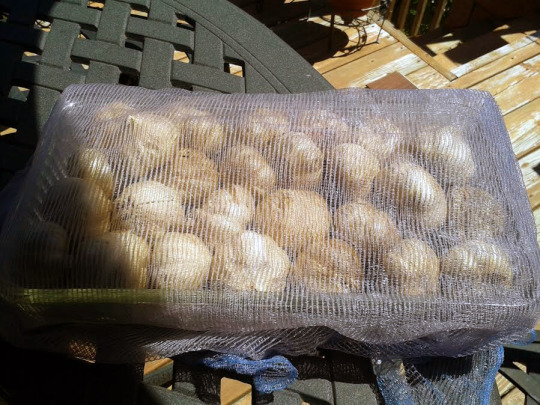
Because I was expecting the entire process to take at least three weeks, I started the treatment process around June 25th. It surprised me how easy it was to make something touted to be so expensive; there weren't really any intricate steps involved with the bulbs once it was placed in the rice cooker. It was simply placing it in the contraption, turning it on, and setting it aside until the process was complete.
I received constant (mostly nocturnal) updates on the severity of the smell. According to my friend Aaron, the smell didn’t really reach any of the rooms. But the entire garage was permeated with a sharp garlic scent for weeks, even after the rice cooker was cleaned and removed from the area.
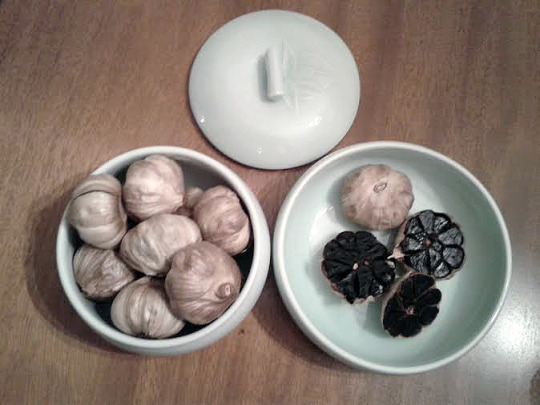
The end results were as expected, all in its jet-black and stinky glory. Its flavour is rather hard to describe; there‘s some sweetness to it, some savouriness with a touch of earthy tone: a bit like a cross between caramelized onion and balsamic vinegar. To be honest, it’s not good by any means. Like, I was actually kind of upset for a good 5 minutes because it just was not worth all that effort. Would it be better if I incorporated it in a recipe? Absolutely. But consuming it in its raw form seems a bit, I don’t know, unbearable. However, I can see myself taking it like a pill, solely for its supposed nutritional benefits.
Each garlic clove has a delectably soft, gelatine-like texture to it, almost to the point of being sticky. The only food I can think of with a remotely similar texture to it is a traditional East Asian dessert called 羊羹 (yōkan) or 양갱 (yanggaeng). Its mouthfeel can only be described as a slightly hard gummy bear; some pieces were incredibly soft, while some just felt mushy. I’m not entirely too sure why the texture varied so much, but something tells me I should have left it as is for an extra week or so.
An article published on Munchies introduces the black garlic and the myriads of ways it can be used in a recipe. Chef Kevin Meehan of Kali, his newly opened restaurant in Los Angeles, is more or less an advocator of the specialty. He incorporates it in three out of the 11 dishes on his menu, which includes a beet tartare, a wheatberry risotto (which sounds incredible), and a beef dish with burnt onion jam. He even talks of experimenting with black garlic ice cream, which, honestly...should not happen.
Black garlic, Meehan declares, is "the ultimate form of umami."
It’s still surreal to me that you can naturally (well, mostly natural) modify a raw food and give it an added nutritional boost—and the fact that you can do it in the comfort of your own home is just an added bonus. So there really is no reason to be gulled into these faux-health “foodie” trends; the only difference between paying more than you should when you can make it at home is being fooled by clever (not-so-clever) marketing.
My consensus on black garlic? Well, aside from just eating a few cloves like it’s some sort of absurdist snack, I have yet to try out a recipe that incorporates it. My primary interest in black garlic was actually more for its medicinal value than anything. I do want to incorporate a more health-oriented approach to my cooking. And black garlic’s benefits of reducing inflammation and osteoarthritis, boosting immune function, and improving cardiovascular health and circulation, all the while tasting decent (it’s inherently an acquired taste) is an A+ for me.
Next up: fruit hunt! I’ll definitely be making something peach-related as peaches are probably my favourite food. Like, my fervour for peaches can be summed up by this single, nonsensical scenario: I would probably get by just fine on a deserted island...if that deserted island also had an abundance of peach trees.
P.S. Here’s a clip from that Bob’s Burgers episode I mentioned before.
youtube
0 notes
Photo
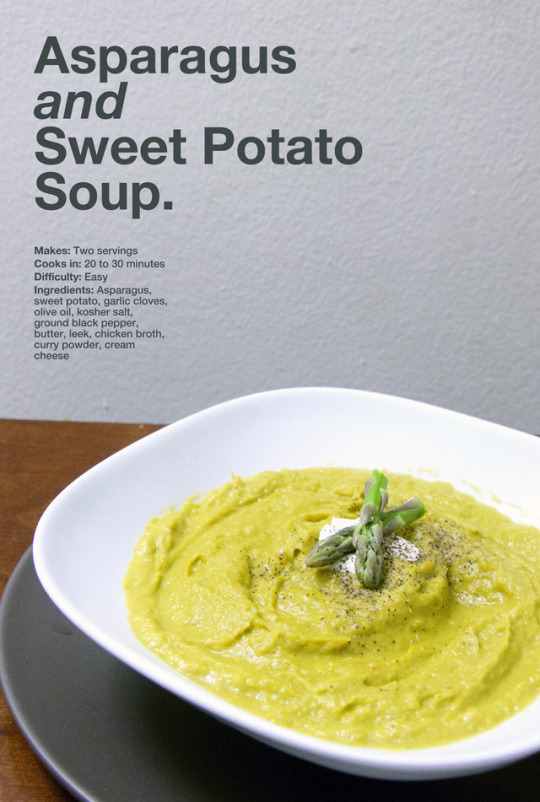
Before I delve into the actual relevant bits of this blog post, here is a quick preface: to be perfectly candid, I’ve always considered myself to be partial to most soups. Growing up in a Zainichi-Korean household, soups and other broth-based dishes were rarely regarded as a holistic meal, but just as a “side-dish”; this may seem like a pretty sordid categorization, but so it goes.
While the approaching summer weather certainly isn’t calling for a hearty bowl anytime soon, the curriculum’s current focus on soup and stock making has inspired me to study, research and familiarize myself with the art of soup—from the rich purées of vegetables and cream taken from the soup-making traditions of Central Europe, to the Maultaschen, hailing from southern Germany. Learning and marveling at these different types of soup made with a carnival of ingredients has been a revealing culinary experience, and once again reaffirmed the fact that there are endless possibilities within the world of culinary arts.
The soup I decided to make for this assignment is called Asparagus and Sweet Potato Soup, taken from the fantastic cooking blog Kitchen Confidante. Asparagus and sweet potatoes are probably two of my favourite foods of all time, and I could have never imagined there would be a soup combining the two. The combination and balance of different flavours have always been a fascinating aspect of culinary arts to me. For the longest time, I’ve been cooking with this unfounded, false notion that flavour profiles that are strikingly opposite from one another should never cross. Experimenting with recipes and flavours is plausible, but to produce a dish that succeeds in combining an uncanny combination of ingredients is, personally, one of the many wonderful aspects of cooking.
The original recipe asks for roasted asparagus and sweet potatoes, but due to the current less-than-adequate state that my oven is in, I compromised and decided to sautée them instead. Other noteworthy details are the inclusion of small ingredients, such as the Korean pepper flakes, inspired by my own culture, and my fascination with fusion foods. In addition, I’m a self-proclaimed improviser; chaos and uncertainty come first in full comfort to get me into a creative spurt before any structured plan can even happen. Perhaps this is why I always consider recipes to be de rigueur (although a strict protocol is what should come first). But for now, I’ve decided to go off the rails, just a bit.
Asparagus and Sweet Potato Soup
Ingredients
1 pound asparagus, sliced into 1 inch pieces
1 sweet potato, cut into 2-inch chunks
3 garlic cloves
¼ cup extra virgin olive oil
Kosher salt, to taste
Freshly ground black pepper, to taste
2 tablespoons butter
1 leek, trimmed, cleaned and sliced
2½ cups vegetable or chicken stock
½ teaspoon curry powder
¼ teaspoon Korean pepper flakes
2 tablespoons of cream cheese
Recipe
Toss the asparagus, sweet potato and garlic cloves in olive oil and sautée in a pan. Season with salt, pepper, and Korean pepper flakes. Cook until the sweet potatoes are fork-tender,
In a saucepan, melt butter over medium-low heat and add the leeks and the roasted garlic. Cook until the leeks are transparent.
Add the asparagus, sweet potatoes along with the vegetable stock and curry powder. Bring to a low boil, and place in a blender.
Blend the soup and return the purée to the saucepan to reheat. Add cream cheese and let it melt.
Serve immediately, garnished with cream cheese and freshly ground black peppers, if desired.
I began the recipe by snapping off the ends of the asparagus and cutting the stalks into 1-inch slices. The sweet potatoes were, of course, peeled and chopped into 2-inch pieces, as directed by the recipe. In addition, the recipe also calls for 4 garlic cloves which I sautéed together with the ingredients to infuse the garlic’s essences and flavours with the two ingredients.
I seasoned the asparagus and sweet potato with salt, pepper, and Korean pepper flakes, generally available at any East Asian grocery market. The pepper flakes are a staple ingredient not just in kimchi, but in a myriad of different Korean dishes. The piquant profile isn’t as direct or forceful in comparison to, let’s say, to peperoncino. Instead, the heat builds up gradually, with force. Use with caution!
Once the asparagus, sweet potatoes, and garlic cloves were done, I removed the garlic into a separate bowl for later use. I melted the butter in a pot over medium-low flame, adding the leeks and the aforementioned roasted garlic. Some more salt and pepper were used for seasoning.
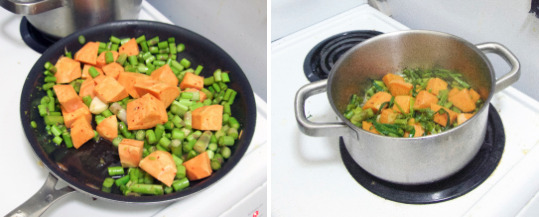
Once the leeks were cooked, I added the asparagus, sweet potatoes, vegetable stock, and curry powder, and let it simmer and bubble 10 minutes until all the vegetables were tender.
Afterwards, I transferred the soup into a blender. Trying gauge the right consistency of the soup was the most challenging aspect of the recipe. I puréed the soup about 4 to 5 times to get it to its final texture, yet it still felt too thick (although admittedly I was using a very old blender).
I also noticed that the blended leeks produced what I can only describe as a “stringy” texture to the soup. After some research, apparently this happens if the leeks are undercooked—a tip diligently noted and saved for future cooking endeavours.
Once the texture of the purée became softer and creamier, all the ingredients now completely blended, I retransferred the soup back to the pot, adding cream cheese and further seasoning to taste. I garnished the soup with a dab of cream cheese, some asparagus heads I quickly sautéed in butter, and freshly ground black pepper to top it all off.
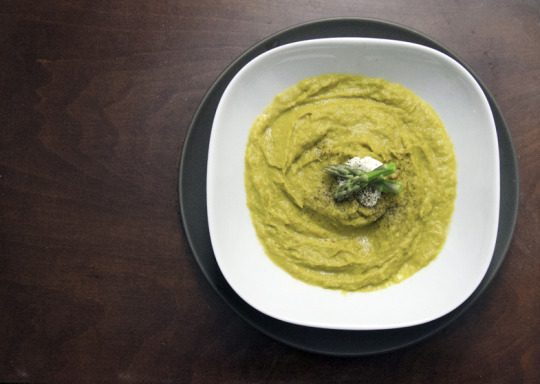
The soup was, overall, a mild success. I was a bit skeptical about it due to the heavy consistency of the soup, as well as the less-than-satisfactory performance of my blender (it kind of looks more like a purée than a soup). But contrary to how it looks, the soup was, for the most part, smooth and “velvet-like”. The sweetness of the sweet potatoes, admittedly, was a tad overshadowed by the flavours of the asparagus, yet I found the cream cheese to be an effective aid in “tying” the sweet and savory palettes together. I didn’t experience too much piquancy from the pepper flakes, but it seemed as if the balance between the pepper flakes and the ground pepper were just enough to merit a touch of a subtle spicy aftertaste to the soup. Oddly, I enjoyed the soup more once it was luke-warm (but then again, I am the odd rarity that prefers all foods cold—or warm—over piping hot).
Because I live alone, I packed up the soup and headed towards Chinatown for my friend Aaron for a taste test. Aaron, being sick as he was at the time, gave it a positive verdict. He noted the harmony of sweet potatoes and asparagus as a surprisingly delectable combination (he initially didn’t want to eat it after I disclosed the ingredients to him). However, he didn’t quite “understand” the necessity of the leek, as the flavours were mainly saturated by the sweet potatoes and the asparagus. He tried dipping rye bread into the soup, which, to quote him was “a mistake”. Other than that, a success!
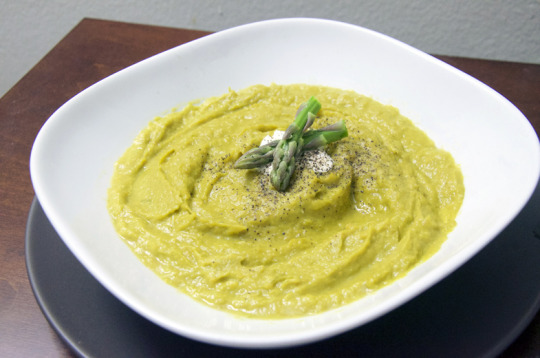
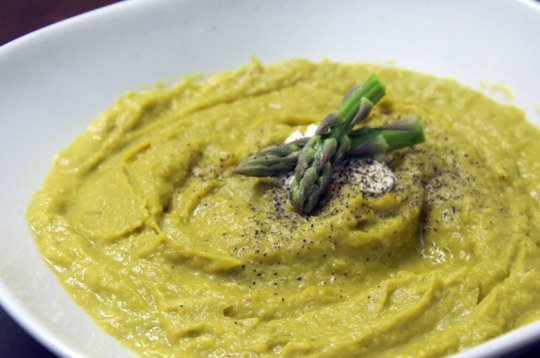
To reflect back on my preface in retrospect, soup has personally never been an integral part of cooking and food. But through this experience—through learning and studying, first-hand, the trials and tribulations in preparing soup, as well as the joys from the wonderful, immense flavours you can achieve from them, I have made it a mission to keep an open-mind during my culinary career. No food—no matter how simple, how plain, or how “basic” it may seem—is undeserving of the uttermost attention, care and respect that should go into every dish that a chef is responsible for.
(All words and photography by Wooju Lee)
0 notes
Link
Just a little playlist I made compiling some of the tunes I like to have on while cooking. Or just about doing anything, really.
0 notes